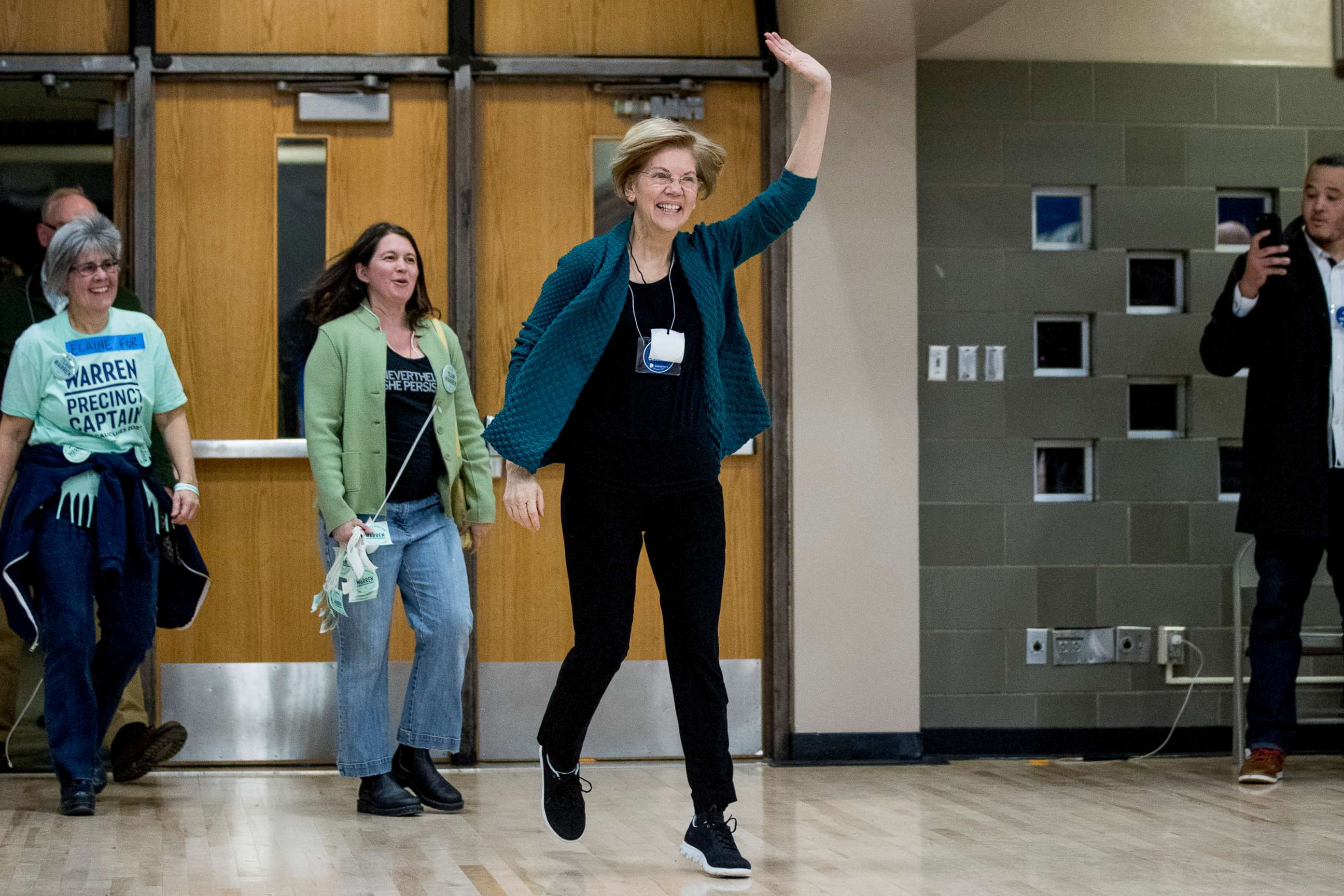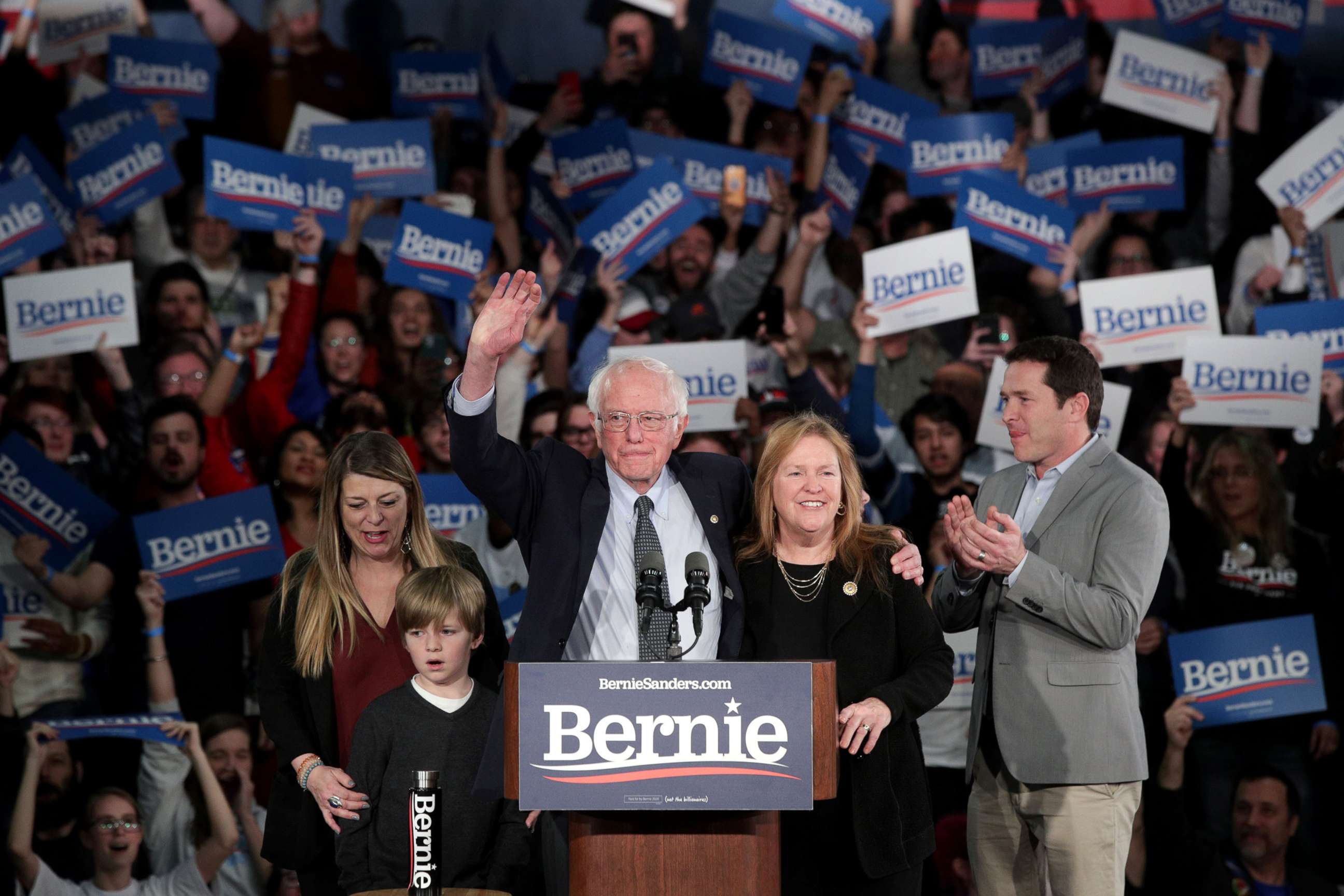In Iowa entrance poll, Buttigieg shows broad-based appeal; Biden, not so much
Younger, more liberal and issue-focused voters pulled for Sanders.
Broad-based appeal lifted former South Bend, Indiana, Mayor Pete Buttigieg in the Iowa Democratic caucuses while younger participants, strong liberals and issue-focused voters pulled for Sen. Bernie Sanders. Former Vice President Joe Biden ran well among seniors in the ABC News entrance poll, but struggled mightily in some key groups, including those focused on electability.
The entrance poll results – reflecting initial preferences rather than the final outcome of the caucuses – represented a boost for Buttigieg while marking challenges facing Biden.
In a telling result, participants by a broad 61-37% said they’d rather see the party nominate the candidate with the best chance of winning in November than the one who “agrees with you on major issues.” But Biden, who’s campaigned on his ability to win, only split electability voters with Buttigieg.
Among those who cared more about a fit on the issues, by contrast, Sanders won 36%, Buttigieg 21% – and Biden a mere 5%.

Biden suffered, as well, at the hands of younger voters: Among those under age 45, he won a mere 4%, compared with Sanders’ 41% and 21% for Buttigieg. Helping Sanders, the ranks of younger participants increased to 45% of those who turned out, up from 36% four years ago.
Biden climbed to 33% support among seniors; Sen. Amy Klobuchar and Buttigieg came next, with 22% and 21%, respectively.

Ideologically, 68% of caucus-goers identified themselves as liberals, matching the record in 2016. Sanders won liberals, with Buttigieg and Sen. Elizabeth Warren next. (Sanders prevailed especially among “very” liberal caucus-goers; here Warren came second.) And among moderates – Biden and Buttigieg tied.
Indeed, Sanders won more liberals than moderates by better than 2-1, Warren did the same by 3-1, and Biden did the opposite, winning more moderates than liberals by 2-1. Buttigieg, by contrast, ran about evenly in both groups.
On one hotly debated issue, 57% supported a single, government-run health insurance plan – an approach backed by Sanders and Warren – vs. 38% opposed. Candidate support followed, with better results for Sanders and Warren among single-payer supporters than opponents. Among critics of a single-payer system, Buttigieg pulled ahead of Biden, 33% vs. 27%.
Health care was by far the top issue out of four that were tested in the entrance poll. Forty-two percent of Democratic caucus participants called it the most important issue in their choice; of the rest, 21% picked climate change; 18%, income inequality; and 13%, foreign policy.
Buttigieg’s cross-group appeal was evident in the issues list: His support was about the same among caucus-goers focused on health care, climate change and foreign policy alike, albeit dropping off among those most concerned with income inequality. Sanders also did well across three issues, in his case income inequality, climate change and health care, with a drop-off among foreign policy voters. Warren did her best among those focused on income inequality. Biden prevailed on the issues list only among participants who cared most about foreign policy, the lowest-rated item.
As in 2016, independents in the entrance poll tilted toward Sanders – a potential challenge for him in closed primaries ahead (those open to Democrats only). He won 34% of independents, vs. 20% of Democrats. But Biden did no better among Democrats – 18% – and Buttigieg, again, won two in 10 in both groups.
Demonstrating the challenges of marshaling support in a crowded race, while Sanders won 48% of participants younger than 30, that compares with 84% in the two-person race in 2016. He also fell off sharply among 30- to 44-year-olds. That said, Hillary Clinton won 69% of seniors in 2016; Biden won just half as many this year.

Biden, who has polled strongly nationally among blacks, a key Democratic constituency – had to contend with comparative lack of racial or ethnic diversity among Iowa caucus-goers. Ninety-one percent were white. That said, among the comparatively few nonwhite caucus-goers, Sanders won 43%. His competitors were clumped distantly - Buttigieg, 15% among nonwhites; Biden, 13%; Warren and entrepreneur Andrew Yang, 12% apiece.
Many participants decided late in the game; 36% of caucus-goers made their final decision in the last few days, way up from 16% in 2016. Sanders’ support was comparatively weak among late-deciders – 13% – while Buttigieg prevailed in this group, with 23%.
There were fewer first-time caucus attendees – 37%, vs. 44% in 2016 and even more, a record 57%, in 2008. Sanders and Buttigieg did especially well among first-timers; Biden, especially poorly. Sanders had 31% in this group; Buttigieg, 25%; Warren, 14% – Biden, just 8%.
The entrance poll measured preferences among caucus-goers as they entered the caucuses. The state party also was to report results after those backing low-performing candidates get a second pick, in addition to, ultimately, final results based on convention delegate allocations.
This analysis is based on entrance poll results available as of midnight Monday. Data were to be updated to reflect final totals from the state party, which were delayed.




